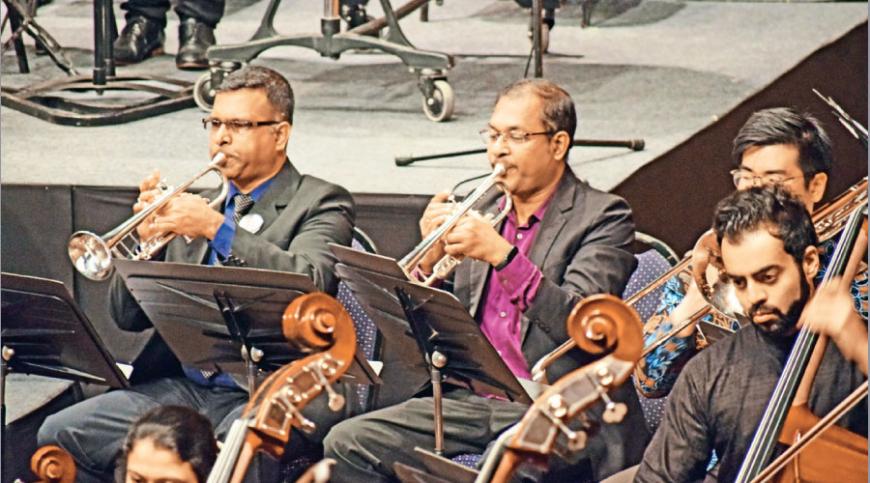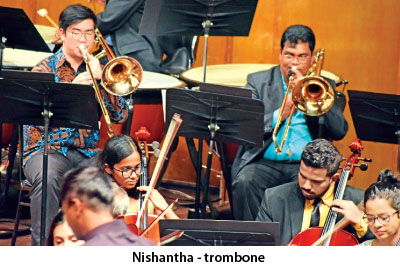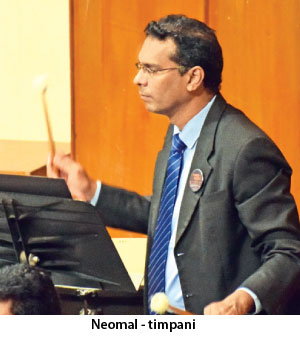
“Music is a way of making sense of the world, and of what South Asia is today. We are aware of the divisions that separate us, the partitions that belong to our history and the tensions that tend to create barriers between all the nations in the region. An orchestra serves as the perfect analogy for regional ties, an audible demonstration of what harmony is possible here” – Nirupama Rao – Founder-Trustee of the South Asian Symphony Foundation.
The J N Tata Auditorium at the Indian Institute of Science was packed to capacity with an enthusiastic audience. The air was electric as players from India, Sri Lanka, Nepal, Afghanistan, Kazakhstan, Singapore, Bangladesh, Bhutan and the South Asian Diaspora from the United States and Europe walked on stage and took their places. They were followed by the conductor for the evening – Alvin Arumugam. A solemn and dignified rendition of the Indian National Anthem set the mood for the evening.
As the Orchestra members recessed, Nirupama Rao – former High Commissioner of India in Sri Lanka, and later Foreign Secretary in India, introduced the South Asian Symphony Orchestra, the mission of the South Asian Symphony Foundation, and the music that was to be performed.
The Harmony Children’s Chorus, conducted by Sandra Oberoi then took the stage to sing six songs of peace including ‘Peace is my Dream,’ the lyrics of which were written by Nirupama Rao, and which forms the basis for the Foundation and it goals. As the name implies, it was a children’s choir, and of a school standard. They were not able to hold the audience through the 6 songs they sang. The accompanist did little to energise the singing and the audience was getting noticeably fidgety. Performers often do not realise that a shorter performance could gain more appreciation from an audience!
The orchestra came back and performed an interesting piece of music which was specifically composed and arranged for the South Asian Symphony Orchestra by Lauren Braithwaite. ‘Hamsafer’ sews together a tapestry of music from several countries, with a thread running through Sri Lanka, India, Nepal, Afghanistan, Bhutan and Bengal. The intertwining of cultures was seamless in its performance with the musicians moving from one to another with ease, always in character. A distinct oriental feel about the entire composition was amply brought out by the orchestra.
Beethoven’s 4th Piano Concerto followed with Julian Clef as the soloist. One expected wide contrasts and fire in its performance, but the performance was somewhat muted. Could it be that the piano did not lend itself to Beethoven? After all, it was not a concert grand, but a 6’+ YAMAHA grand piano. Many phrase beginnings were not quite in sync between the pianist and the orchestra giving rise to some level of uncertainty. Overall, it was a creditable performance. The audience acknowledged that fact by applauding after each movement, and the conductor graciously accepted the appreciation.
A short intermission followed that pretty long 1st half which spanned a good 180 minutes!
The second half opened with a composition by Anand Antonius Nazareth titled ‘Ideas of Freedom – a tribute to Mahatma Gandhi’. Fascinating research points to the music that Gandhi listened to and some of them – notably the hymn Lead, Kindly Light and his favourite bhajan ‘Vaishnava Jana to’ echo in this composition which saw the inclusion of Sitar and Tabla into the orchestra. Nazereth’s exposure to music in Europe and the USA gave the composition a tinge of the western sounding arrangements, which were yet oriental in texture. This was another interesting and enjoyable composition premiered by the SASO. Sitting through rehearsals for nearly a week, I witnessed the composer working closely with the conductor to optimise the interpretation of his composition by the orchestra – and he seemed happy with the result! For the listener, it was a great experience in music.
Next on the program was a speech by Arson Fahim – a 19 year old from Afghanisan. He was billed to talk about the challenges faced, particularly by youngsters who wish to pursue music in Kabul. I have heard his story on previous occasions too. While he started off well and had the audience with him, he moved onto quotes and less interesting information, and seemed like he would never stop. The audience was getting fidgety once again and Nirupama had to step up to Arson and request him to cut short his speech. He did wind down, but followed it with playing one of his compositions on the piano (out of the program). This item, added to the long drawn out performance by The Harmony Children’s Chorus contributed to a tired audience and orchestra too. This seemed to impact the fate of the final work for the evening which was possibly Beethoven’s best known symphony No.5. The adrenaline kept the orchestra going and the best known movement – the first was well played. As expected, the audience demonstrated their appreciation by applauding at the end of the first movement which the conductor graciously acknowledged and then decided to go for an abridged version in consideration of the duration of the concert which spanned 4 hours including the intermission.
Even after a 4 hour concert, it was amazing how long it took the audience to clear out. Many of them converged onto the stage to congratulate Nirupama, the Conductor and orchestra members. The SASO had done it! They had been able to leave a mark on its audience, some of who were enthusiastic about supporting the Foundation in its efforts to bring peace through ‘music diplomacy’.
After the concert I was chatting to Alvin Arumugam, the Conductor whose roots are from Sri Lanka. Looking beyond the music he had just conducted, he had some very interesting thoughts which he shared with me. He said “One of the most interesting things about an orchestra is when they first meet. In a festival orchestra such as SASO musicians of South Asian descent from all over the world come and sit together for the first time; within the first ten minutes, so much of communication has taken place.
The kind of communication referred to is about agreeing on how the sound should be, on who should lead and who should follow; about timbre and pitch and all other aspects of what would go into the performance. These are complex things and what is amazing is that all of these things are communicated and agreed on without words – within the first ten minutes!
The model of an orchestra can and should be used by people who run companies, people who run governments and politicians; who would find it very interesting to sit in and see how musicians with language barriers, cultural barriers, traditional barriers come together and make music without words. That is truly the miracle of a Symphony Orchestra.”
The concert was staged in commemoration of the 150th birth anniversary of Mahatma Gandhi and carried the slogan ‘from Gandhi to Beethoven: the Call to Freedom’.
